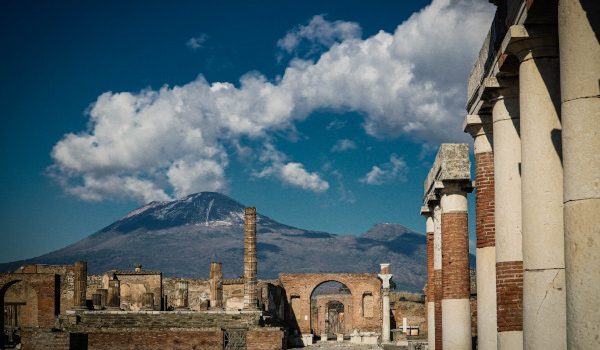POMPEII PREPARES FOR CLIMATE CHANGE
Monitoring with the aid of advanced technology
thanks to an agreement with the University of Salerno
No damage to the cultural heritage of the site of Pompeii has been detected following the bad weather of recent days, which triggered a yellow weather alert in certain parts of Campania, including the Vesuvius area. Meanwhile, the increase in weather events of high intensity that has been recorded in recent years, attributable to a broader context of global climate change, has not been accompanied by inactivity amongst the staff of the Archaeological Park which, due to the long history of the excavations and the unique conformation of the archaeological heritage, exhibits particular vulnerabilities.
More specifically, the frequent transition between extremes of drought and heavy rain increases the physiological stress to which the ancient structures are exposed. With the aim of developing innovative solutions for monitoring the heritage, whilst making use of advanced technology, an agreement has been signed with the Department of Civil Engineering of the University of Salerno.
The agreement provides for the development of specific procedures and methodologies of screening for conditions of instability, deterioration and fragility which can cause critical situations or reduce structural safety. Applied research activities will also be implemented through the development of theses and educational internships.
It is thus intended to integrate the activities of monitoring, planned maintenance and the planning of new interventions conducted by Park staff with technological tools that are able to better target preventive protection measures and ordinary maintenance.
“To this end” – declares Gabriel Zuchtriegel, Director of the Archaeological Site – “we are implementing the information system on the GIS platform that was developed as part of the Great Pompeii Project. Clearly defining the entire process, from monitoring until the intervention, as well as optimising the planning of stabilisation and restoration interventions, will allow us to better quantify the increase in human and financial resources which we will need to mobilise in the years ahead to address the impact of climate change on cultural heritage. Today we already have worrying data regarding the effects of climate change on heritage; we must not close our eyes to it but work hard so that the climate crisis does not also become a crisis of cultural heritage”.
The monitoring project stands in continuity with the project of planned maintenance launched under the direction of Professor Massimo Osanna some years ago, which saw a permanent team of 55 professionals working on the site, including restorers, specialist workers, archaeologists and architects.
“The pattern with which weather events of high intensity and short duration occur” - explains Professor Luigi Petti – "often interspersed with periods characterised by drought and high temperatures, poses a new challenge for the preservation of exposed cultural heritage, such as that of the Archaeological Park of Pompeii. Gusts of wind and storms could in fact lead to the rapid deterioration of ancient buildings present in Pompeii, and in the case of exceptional events, lead to dangerous conditions. As part of the institutional activities of the Archaeological Park of Pompeii, Director Gabriel Zuchtriegel has, with the support of the Department of Civil Engineering at the University of Salerno, launched the development of an innovative model for managing planned maintenance and preventive protection measures that are able to mitigate and control the impact of such phenomena on the ancient city. The project enhances the considerable skills and tools already present in the Park with cutting edge research and experience developed at the University of Salerno, including the monitoring of the Temple of Neptune at Paestum and the monitoring and surveillance of bridges, viaducts and tunnels on the A3 motorway section.”


